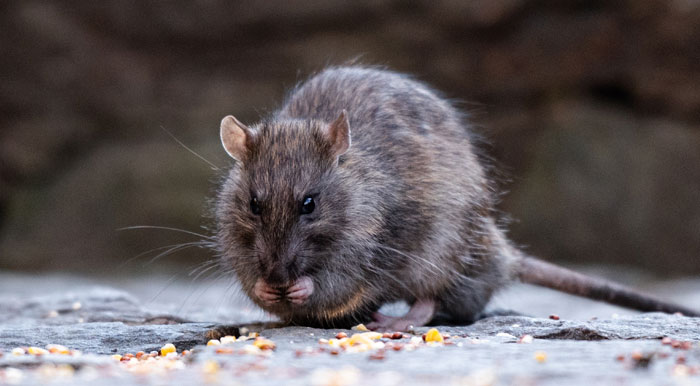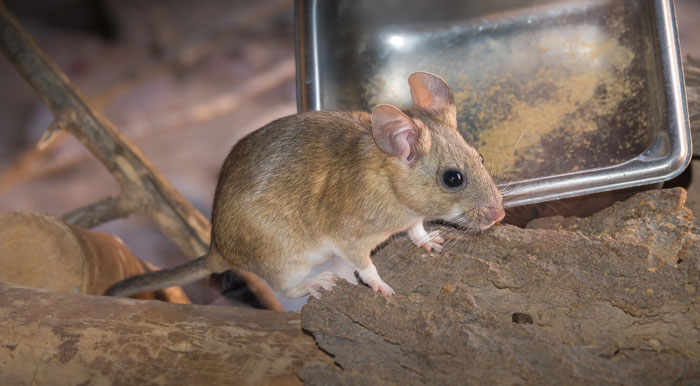
There are 56 species of rats throughout the world. Norway rats, Roof Rats, Ship rats, Wood rats and Marsh rice rats are the most common to the United States.
Like their mouse cousins, rats are classified in the family Rodential. And, like mice and other members of the rodent family, rats are distinguished by their incisor teeth, which grow continuously. Because their incisor teeth are always growing, they need to gnaw on nearly anything – wood, paper, plastics, wiring, food and food packaging – to keep those teeth at a bearable length. This, along with their propensity to carry and spread disease, is why they are considered among the most damaging of pests.
Rats resemble mice but rats are larger than mice, weighing between 5-18 ounces and ranging in length from 10-18” long. Their heads and feet are disproportionately larger in comparison to their furry bodies.
Rats live mainly in the wild, preferring to live near humans. Some rats are also used in lab research and, despite their destructive, disease-carrying nature, some rats are household pets.
Types of Rats in Pennsylvania, New Jersey and Delaware

Norway Rat (Brown Rat)
(Rattus norvegicus)
The Norway rat is also known as the brown rat, sewer rat, barn rat or water rat. This is the most common of rats in the United States, living primarily near urban areas where they will burrow their nests into the ground or any place they can find. Norway rats are also the largest of the species, with bodies that are 8-10” in length, tails between 7-10” long and weights ranging from 9-12 ounces. Their fur is a combination of brown and dark gray. They have short ears and small, beady eyes. Not only is their eyesight poor but they are colorblind. This is the species of rat most often chosen as a domestic pet.

Roof Rat (Black Rat)
(Rattus rattus)
The Roof rat is also known as the Black rate and Ship rat. Their bodies measure 5-7” long with tails that grow between 6-8”. They have long ears and black, gray or brown fur. Roof rats are known for their climbing ability and usually choose to nest above ground. The Roof rat is the one most commonly found in home infestations. They are omnivores that will eat most anything, including birds, seeds, fruit, pet food and food meant for farm animals. It is believed that the Roof rat is the main cause for the spread of the bubonic plague throughout Europe in the 14th Century.

Allegheny Woodrat (Pack Rat)
(Neotoma magister)
The Allegheny Woodrat is also known as the Pack rat because it will seek out and collect shiny items (coins, nails, bottle caps) to bring back to its nest. These rats are 6-10” long with a tail 6-8” long, weighing between 9-14 ounces. This rat has a mouse-like appearance with grayish-brown fur, large ears and large black eyes. They will build nests in rocky areas or homes. Due to a population decline, Pennsylvania has declared the Allegheny woodrat a threatened and protected species. They will eat small mammals as well as seeds, insects, nuts and leaves.
Signs of an Infestation
Rats will seek refuge in homes when they are in need of shelter and a reliable food source. This is especially true for Roof rats who prefer living with humans. They can often be found in eaves, rooflines and attics.
Rats are nocturnal, so you may not have a sighting. Be on the lookout for:
- Live or dead rat sightings
- Rat droppings
- Dirt or grease marks along floorboards and walls
- Rat runs – worn paths leading into your home
- Chewed wood, plastic or food packaging and contents
- Holes in floorboards
If you do see a rat, especially during daytime hours, it’s pretty likely you have an infestation.
Health and Damage Considerations
Rats cause significant damage to property as a result of their constant gnawing. The damage can be minor – food packaging, plastics – or truly dangerous, causing structural damage, electrical fires.
Rats are notorious for spreading disease, either through a rat bite, direct exposure to infected feces and urine, or from fleas and ticks that are on the rats. These diseases include:
- Hantavirus Pulmonary Syndrome
- Leptospirosis
- Lymphocytic Choriomeningitis (LCMV)
- Salmonella (food poisoning)
- Rat-bite Fever
- Plague
- Colorado Tick Fever
- Cutaneous Leishmaniasis
- Weil’s disease
Behavior
Rats are considered commensal animals because they prefer to live near or with humans for shelter and a food source. When large, rat populations will develop into a hierarchical society where the weaker rats will be subordinate to the stronger rats. Rats will react aggressively when they perceive a threat, fighting, chasing, boxing and biting who or whatever is provoking them.
Habitat
Rats are found all over the world, living primarily in urban areas but they can also thrive in suburban and rural environments. Anywhere in proximity to humans. Rats are mostly burrowers, building their nests in the ground, at the edges of landscaping or patios and inside the walls of homes and other structures. Woodrats prefer burrowing in rocky terrain located in woodlands. Roof rats live in trees and shrubs or attics, eaves and roof lines of buildings.
Lifecycle
Rats live 1-3 years. Female rats are able to breed at two months of age but generally don’t begin reproduction until they are 5 or 6 months old. The rat gestation period is 21-25 days resulting in litters of 6-13 pups. A female rat can produce 5-10 litters each year.
Feeding
Rats are omnivores and while some species prefer certain foods, they will eat a wide range of foods. Norway rats will choose high protein foods like meat and pet foods while Roof rats prefer fruits. If food is scarce rats will feed on each other.





